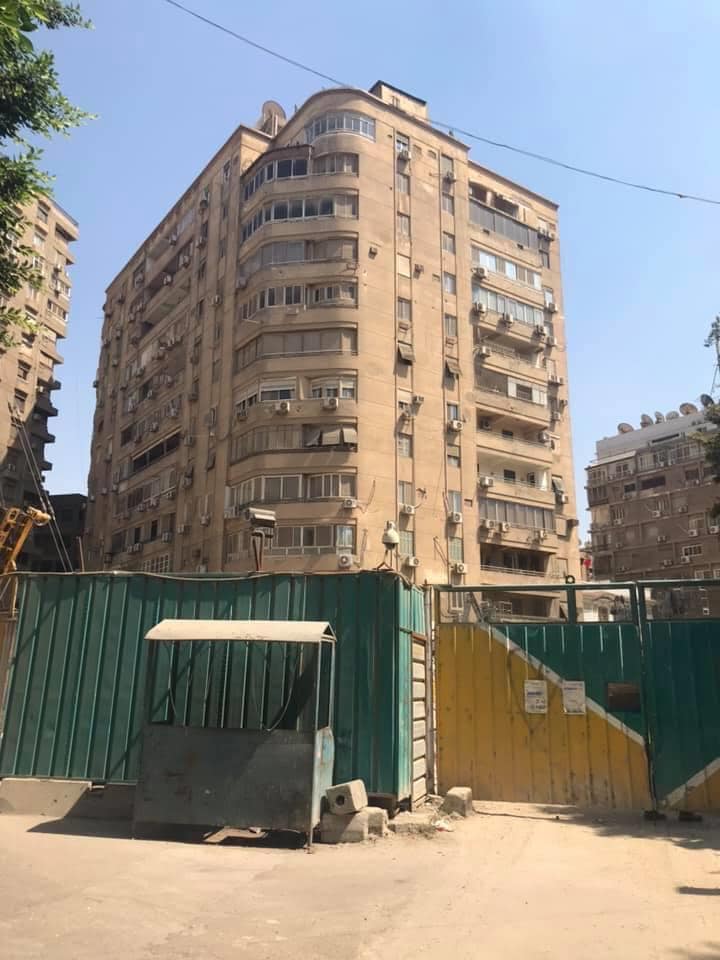
Egyptian authorities on Sunday have evacuated an apartment building in Cairo’s Zamalek neighborhood that has begun to sink on one side, causing the structure to lean.
Cairo governor Khaled Abdel-Aal checked on the building, known as the Sharbatly building, and ordered an engineering committee to inspect it and find out the extent to which it is affected by the sinkhole.
The property consists of two parts, the first of which overlooks Brazil Street and consists of 12 floors and 37 apartments. Sixteen of the apartments are inhabited and 21 are vacant.
The second part of the building overlooks Aziz Abaza Street, and has 11 floors containing 33 apartments, 28 of which are inhabited, and five of which are vacant.
Initial inspection showed damage, including cracks, a sinkhole under the garage, and a sinkhole near the entrance.
Maha al-Tarabeshi, a resident of a building adjacent to the leaning property and a vocal activist against the extension of the Cairo metro into Zamalek, blamed the metro construction project for the sinkhole, adding that digging related to the construction has been a source of great annoyance over the past several years.
During a call-in with a television program on the state-owned Channel One, Tarabeshi said the building has been subjected to intense shaking, especially at night.
She added that the cracks in the Sharbatly building led to the evacuation of the adjacent building as well, and that residents were evacuated in their pajamas and have not been allowed to reenter the building.
“There were signs of the cracks that affected the Sharbatly building, as well as the sinkholes. We reported this issue, and we expected a catastrophe. We live in a nightmare now. I was born in Zamalek and my grandchildren reside here. There is no alternative place for us,” Tarabeshi said.
She said that most of the families cannot afford to live in hotels or to purchase new apartments, stressing that no compensation has been paid to residents of the neighboring building to help them obtain temporary housing, which is what happened with the residents of the Sharbatly building.
For his part, Transportation Minister Kamel al-Wazir said that people should not rush to judgment and perceive the situation of the building as serious without receiving the results of specialized engineering committees.
During a call-in with Ahmed Moussa’s TV show “Ala Massoulity” (On My Responsibility) on the privately-owned satellite channel Sada al-Balad, Wazir said that an engineering committee from Ain Shams University is currently at the site.
“The building is not leaning and has no cracks. Contrary to what was reported, there is no danger to the building,” he said.
Wazir pointed out that his Ministry paid LE30,000 compensation to each family so they can obtain alternative housing for one month.
A resident of the leaning building Dina Zul-Fakar, echoed the same sentiments of Tarabeshi saying that residents were so panicked that they even left their clothes behind.
During a call-in with the television channel al-Hadath al-Youm, she said that the residents of the building only want their homes and will never give up their property or accept compensation to move to another building in the future.
“Now we are homeless, and the LE 1,000 compensation per day for a month is not enough for a family. We need our house and our clothes, since we left all our belongings behind,” she said.
Zul-Fakar also said that the majority of Zamalek residents strongly rejected the metro project from the very beginning but to no avail.
Since 2014, dozens of Zamalek residents have protested the construction of a metro station in their neighborhood, and in 2014 filed a lawsuit with the State Council to stop the metro construction.
Residents have protested that Zamalek is an island and that its soil is weak and is not suitable for drilling work or metro traffic.
Ibrahim Seoudi, the lawyer of the over 40 plaintiffs from the Zamalek district, explained in an earlier interview that the implementation of the third phase of the third line of the subway would place Zamalek area in serious danger, threatening the architectural and cultural heritage of the area.
Nevertheless, there was a substitute route that had been suggested by the Japan International Cooperation Agency (JICA) at the beginning of the millennium, passing through the Kit Kat area then over the Nile via a bridge.
“This route is less expensive and more secure, costing no more than 3 percent of the cost of underground drilling,” said Seoudi, adding: “The subject lacks transparency, and we didn’t feel that there were any serious soil studies in Zamalek.”
The National Authority for Tunnels has explained that this claim has been scientifically proven to be incorrect.




